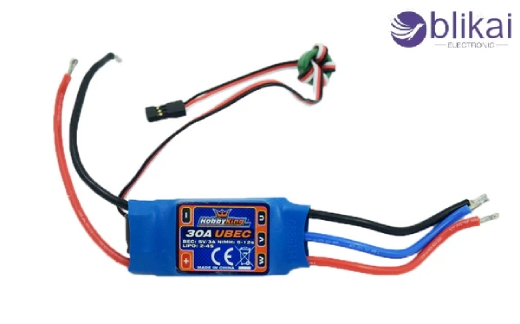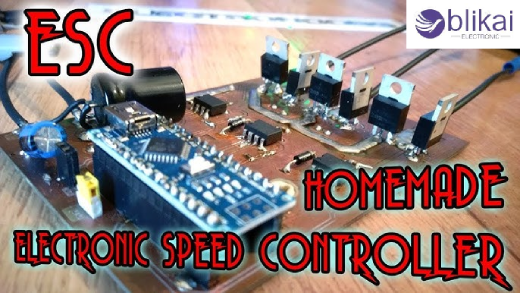What is an Electronic Speed Controller and How Does it Work?
Have you ever thought about how remote-controlled vehicles get such accurate speed control? In any case, it is an electronic speed controller, this tiny yet powerful component that does all the magic.

Understanding Electronic Speed Controllers (ESCs)
Electronic Speed Controllers are vital devices in electric motor systems; they serve to regulate the speed and direction of rotation of a motor. The controller thus becomes the connection between the power source and the motor when the former represents a responsive flow of electrical current towards the latter.
Key Components of Electronic Speed Controllers
An ESC usually comprises a microcontroller, power transistors, and additional circuits that support the operation of ESCs. The microcontroller processes the input signals and manages the power transistors, hence regulation of the motor current flow. It may also involve the inclusion of capacitors for alleviating voltage variation and heat sinks for cooling purposes.
Types of Electronic Speed Controllers
ESCs come in various types, including brushed and brushless variants. Brushed ESCs are generally cheaper with simpler technology-ideal for low-power applications. Brushless ESCs, on the other hand, are more efficient and are adopted in high-performance systems. Some ESCs incorporate advanced features, including regenerative braking or programmable setups.
Applications of Electronic Speed Controllers in Various Industries
ESCs find applications across numerous industries. In robotics, they control the precise movements of robotic arms and wheels. The RC hobby employs ESCs for drones, model aircraft, and cars. In industrial technology, Aggregate utilizes ESCs for conveyor belts and machines. The automotive sector also exploits ESCs to allow electric vehicles to work properly while better controlling motor operating speeds and energy efficiency.
How Electronic Speed Controllers Work
Input Signal Processing
Electronic Speed Controllers (ESCs)-these work from the receiver-or flight controller-are input signals. While these signals are often Pulse Width Modulation (PWM) signals, the newer digital protocols like DShot actually specify the motor speed and direction. A microprocessor on board the ESC is generally responsible for interpreting these signals and converting them into commands for the motor.
Power Regulation Techniques
Once the input is processed, ESCs employ sophisticated power regulation techniques to control the flow of electricity to the motor. This involves modulating the voltage and current supplied to the motor windings. Advanced ESCs use techniques like synchronous rectification and active freewheeling to improve efficiency and reduce heat generation.
Motor Control Algorithms
At the heart of an ESC's functionality are its motor control algorithms. These dictate how the ESC applies power to the motor phases to achieve desired speed and torque. The most common algorithms include sensorless trapezoidal control for brushless DC motors and field-oriented control (FOC) for more precise speed and torque regulation.
Feedback Mechanisms
To ensure accurate motor performance, ESCs incorporate feedback mechanisms. These may include back-EMF sensing for sensorless motors or direct sensor feedback for sensored motors. The feedback allows the ESC to adjust its output in real-time, compensating for changes in load or environmental conditions. This closed-loop control system enables smooth, responsive motor operation across various applications.
Advantages of Using Electronic Speed Controllers
Improved Energy Efficiency
Electronic Speed Controllers (ESCs) significantly enhance energy efficiency in various applications. By precisely regulating power supply to motors, ESCs minimize energy waste and optimize power consumption. This results in reduced electricity costs and improved overall system performance.
Enhanced Motor Performance
ESCs enable motors to operate at their peak efficiency, delivering smoother acceleration and deceleration. They provide better torque control and allow for rapid adjustments to changing load conditions, ensuring optimal motor output across different operating scenarios.
Precise Speed Control
Yet another of the main advantages of ESCs lies in their ability to control speed with better precision. This might enable the user to make minute adjustments in motor speed with unfettered control, allowing smoother operation through precise control from drones to industrial machinery.
Reduced Maintenance Needs
By optimizing motor operation, ESCs help reduce wear and tear on mechanical components. This leads to fewer maintenance requirements, lower repair costs, and decreased downtime for equipment and vehicles utilizing ESC technology.
Extended Motor Life
ESCs protect motors from harmful conditions such as overheating and overcurrent. By regulating power input and preventing sudden surges, ESCs contribute to prolonging motor lifespan, ultimately saving costs associated with frequent motor replacements.

Choosing the Right Electronic Speed Controller
A. Matching ESC to Motor Specifications
It is vital to match an ESC to the specifications of the motor when selecting it, i.e., the ESC should be rated for amperage greater than the motor could use; the difference should be 20 percent over the maximum draw to ensure that the motor operates safely. You will have to take into account the KV rating of the motor and the voltage requirements of the motor for compatibility with the ESC.
B. Considering Voltage and Current Ratings
Voltage and current ratings are critical factors in ESC selection. The ESC's voltage rating must match or exceed your power source's voltage. For current, choose an ESC that can handle the maximum current draw of your motor, plus a safety margin. This prevents overheating and potential damage to your system.
C. Evaluating Programmable Features
Modern ESCs often come with programmable features that enhance performance and versatility. Look for options like adjustable timing, throttle curve customization, and brake settings. These features allow you to modify the performance of your ESC to meet your specific goals, whether you are tuning for racing drones or RC cars.
D. Assessing Cooling Requirements
Proper cooling is essential for ESC longevity and performance. For high-performance applications, consider ESCs with built-in heat sinks or fan cooling. In less demanding scenarios, passive cooling might suffice. Always ensure adequate airflow around the ESC to prevent overheating during operation.
Installation and Setup
Proper Wiring Techniques
Proper wiring is crucial when it comes to installing an Electronic Speed Controller (ESC) to provide maximum performance and safety. First, trace the three main connections: battery, motor, and receiver. Use properly sized wire to handle the current flow, ensure tight connections, and insulate them properly. Where possible, use solder for better conductivity, finishing all with heat-shrink tubing to prevent exposure of wires.
Configuring ESC Parameters
Most modern ESCs come with programmable features. Connect your ESC to a programming card or use the transmitter to access the settings. Common parameters include brake type, timing, and low-voltage cutoff. Adjust these settings based on your specific motor and application requirements. Always refer to the manufacturer's manual for recommended configurations.
Calibration Procedures
Calibrating your ESC ensures smooth operation across the entire throttle range. The process typically involves setting the throttle to its maximum and minimum positions while the ESC learns these values. Many ESCs have a specific sequence of beeps or LED flashes to guide you through the calibration process. Proper calibration minimizes issues like jerky acceleration or inconsistent speed control.
Safety Precautions During Installation
Installation of ESC should have safety as the utmost priority. Disconnect the battery from the system to avoid a motor starting by accident. Always use personal protective equipment like safety glasses while soldering. Proper ventilation should always be permitted in the working area, particularly whenever large amounts of energy (as happens with LiPo) are being dealt with. Always check all connections before turning it on for the first time.
Troubleshooting Common ESC Issues
Overheating Problems
Overheating is a frequent issue with ESCs. To address this, ensure proper ventilation and consider using a heat sink. Check loose connections for shorts or current-drawing shorts and for bad wire. If this doesn't solve the problem, then it may be time to upgrade to a different ESC.
Signal Interference
Signal interference can lead to erratic motor behavior. To avoid such a situation, keep ESC and receiver circuit wires away from motor and battery wires. It helps to use shield cables and ferrite beads to curb electromagnetic interferences.
Startup Failures
When your ESC fails to start, first check the battery connection and voltage. Be sure your battery is fully charged and properly connected. If the issue persists, check if the ESC firmware is updated/compatible with the setup.
Inconsistent Motor Performance
Inconsistent performance often stems from improper calibration. Recalibrate your ESC according to the manufacturer's instructions to ensure proper balance. If problems persist, check the brushes of brushed motors or the magnets of brushless motors.
Future Trends in ESC Technology
Improved Power Efficiency
As energy conservation becomes ever more critical, ESC manufacturers are now more consciously pursuing power efficiency. New designs incorporate advanced power management techniques and high-quality components that minimize power losses. This trend not only reduces operating costs but also increases the battery life of applications dependent on portable power, thus making ESCs more sustainable and effluent-friendly.
Related Articles
Microcontroller vs Microprocessor: What's the Differences? (Guide)
Embedded Systems vs Microcontrollers: What's the Main Differences?
ARM Microcontroller : Features,Applications and Function
MC9S12XHZ256CAG Microcontroller: Overview, Specifications and Applications
STM32F030F4P6 Microcontroller: Overview, Applications, and Datasheet
STM32F407IGT6 Microcontroller: Features, Applications and Datasheet
Comparing FPGA vs Microcontroller: Optimal for Your Needs?
Differences Between FPGA vs Microcontroller
STM8S005K6T6C Microcontroller: Features, Apps & Datasheet Insights
ATMega328P Microcontroller: A Powerful Microcontroller
How Long Do Electrolytic Capacitors Last [Explained]
Multimeter Not Reading DC Voltage: How to Fix it?
Comparative Analysis of DC Transmission and AC Power










